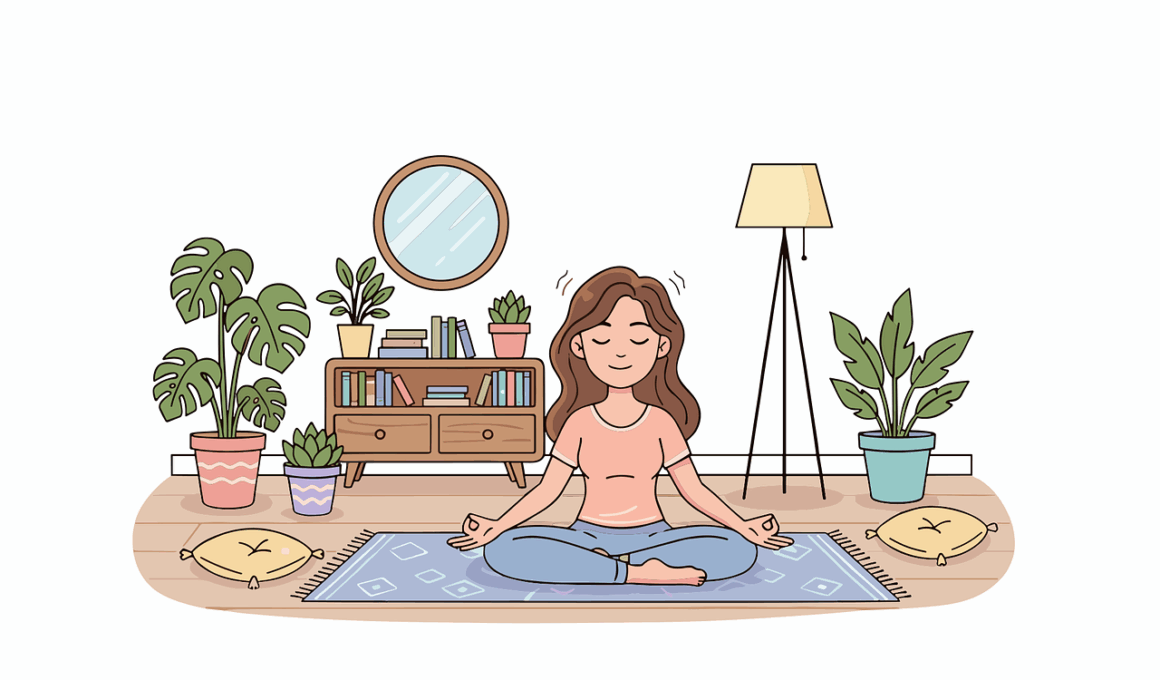Essential Yoga Breathing Techniques for Beginners
Yoga and breath control, or “Pranayama,” form an essential foundation for a successful practice. Focusing on your breath enhances mindfulness, promotes relaxation, and improves energy flow throughout your body. To begin, familiarize yourself with basic breathing techniques such as Diaphragmatic Breathing. This practice allows the diaphragm to fully engage, expanding your lung capacity and ushering in a flow of fresh air. Another technique is 4-7-8 Breathing, ideal for stress management. Inhale for four counts, hold your breath for seven counts, and exhale for eight counts. Regular practice cultivates inner peace and balances emotions. As you explore these techniques, it is vital to remove distractions. Set aside a quiet space free from interruptions and embrace the serenity. Try incorporating visualization during your sessions, imagining inhaling positivity and exhaling negativity. Mastery of these techniques will greatly enhance your Yoga experience, making your practice more fruitful. Incorporating these practices into your routine is about patience and perseverance. Over time, you will notice significant improvements in your flexibility, mental clarity, and overall well-being, setting a solid foundation for your Yoga journey.
Understanding the Benefits of Breath Control
The benefits of breath control extend beyond mere relaxation techniques. Effective breathing methods can promote physical health and psychological stability. They relieve stress and anxiety while improving your focus. Engaging your diaphragm rather than shallow chest breathing promotes better oxygen intake, crucial for detoxifying your body. Additionally, pranayama enhances lung capacity, vital for improved cardio performance. By cultivating breath awareness, you regulate your body’s stress response, which is invaluable in today’s fast-paced lifestyle. Furthermore, consistent practice can lead to improved sleep quality and a heightened sense of well-being. Anxiety may diminish as your breathwork strengthens your connection to the present moment. You might also discover increased energy levels; focus on energizing techniques such as Breath of Fire. This method invigorates your entire being, preparing you for both physical and mental challenges. Incorporate breath awareness into your daily routine—during work breaks or while commuting. Recognize your breath as a powerful tool that controls your state of mind and body. As you begin experiencing these benefits, you’ll cultivate a renewed passion for your Yoga practice and its associated breathing techniques.
Basic Techniques to Get Started
Starting with basic Pranayama techniques can seem daunting, yet it’s achievable with structured guidance. One of the simplest techniques is “Equal Breathing,” wherein you inhale and exhale for the same count. For beginners, a count of four is manageable. Focus upon establishing a smooth and steady rhythm, and soon this balance will become second nature. Another excellent method is “Nadi Shodhana” or alternated nostril breathing. This technique balances the body’s energy and nurtures emotional stability. It’s as simple as closing one nostril while inhaling, then switching for exhaling. Practicing for five or ten minutes daily will build your confidence and improve your focus. Progress to more complex techniques only when comfortable. Listening to your body is essential; if you feel dizzy or light-headed, pause and breathe normally. Remember to maintain a comfortable seated position with an elongated spine. Gradually, you’ll gain familiarity with each technique, allowing for a more profound, transformative practice. Document your experiences to see your progress over time. Engaging in these exercises regularly not only enhances your Yoga practice but also deepens your self-awareness.
Every breathing technique in Yoga requires mindfulness and intention to achieve its full benefits. Maintaining a regular practice schedule is important for learning and perfecting these techniques. Set aside distinct times each week to devote to your breathwork practice; even 10-15 minutes a day is enough for noticeable improvement. Attend classes or watch online tutorials to understand varied approaches better. Engaging with other Yoga practitioners can provide inspirational insights while enhancing your discipline. Keep in mind, Yoga is a personal journey; progress varies with each individual. Try creating an inspiring, serene environment to immerse yourself in your practice fully. Incorporate calming music or meditation aids into your sessions to maintain focus. Don’t rush your learning process; mastery of these techniques unfolds with consistent practice. Journaling your progress not only documents your journey but provides motivation. Revisit your writing to reflect on how these techniques elevate your practice. Celebrate every milestone along the way—whether it’s mastering a new technique or simply feeling more at ease during a session. Remember that embracing the journey is as important as achieving mastery.
Integrating Breathing Techniques into Yoga Practice
Integrating breathing techniques into your overall Yoga practice creates synergy between mind, body, and spirit. As you step onto the mat, consciously incorporate breath awareness into every pose. Align your movements with your breath; inhale while expanding your torso in poses like Utkatasana, or “Chair Pose,” and exhale during the transition back to a standing position. This seamless connection elevates your practice to new heights. When navigating challenging poses, practice pranayama techniques to maintain balance and calmness. Should you hesitate during challenging postures, revert to Ujjayi or “Victorious Breath,” a calming breath practice. This technique not only helps focus your energy but also serves as a meditative anchor throughout your practice. Another invaluable approach is monitoring your breath during Shavasana or “Corpse Pose” at the practice’s close. Allowing your breath to settle helps integrate your practice’s effects. Guide your thoughts back to conscious breathing and observe any emotional or physical changes. Over time, this will enhance your intimacy with Yoga, building strength and resilience. Cultivate a symbiotic relationship between breath and movement to enhance your body awareness and mindfulness.
Conclusion: The Path Ahead in Your Yoga Journey
As you conclude your exploration of these essential Yoga breathing techniques, recognize that mastery lies in consistency and patience. Each practice brings you closer to understanding yourself and the art of Yoga. These techniques offer benefits that stretch beyond the mat, influencing every aspect of your daily life. Embrace your journey, cherishing every small step taken toward development and transformation. Your journey in Yoga is uniquely yours, with personal challenges and accomplishments—their significance cannot be overstated. Reflect and check in with yourself regularly to assess your progress and areas for improvement. Make adjustments as necessary; evolving is part of the process. Seek community by connecting with fellow practitioners and sharing experiences, opening yourself to new insights and perspectives. Engage with various resources, from workshops to books, that deepen your understanding of Yoga and breathwork. Primarily, enjoy the journey—not solely the destination. The more you immerse yourself in these practices, the deeper your understanding will grow, leading to remarkable physical and emotional benefits. Your commitment to integrating these breathing techniques into your lifestyle will enrich both your Yoga practice and overall well-being.
Ultimately, the relationship between your breath and your Yoga practice is profound. Effective breath control significantly impacts overall mindfulness and relaxation. As you progress, practicing these techniques will become more natural and intuitive. The rewards are plentiful; you will likely discover enhancements in your focus, emotional health, and even physical vitality. The principles learned here can transcend into daily life scenarios. Breathing techniques can help manage stress during work, social situations, or at home. Consider these strategies foundational as you unfold your Yoga path. By integrating breath awareness and mindfulness into your daily routine, you foster a deeper connection between body, mind, and spirit. This holistic approach aligns with the essence of Yoga, empowering you to navigate life’s challenges with grace. As your practice deepens, so will your understanding of Yoga and its capabilities. Drawing from experiences, remain open to learning and adapting. Each session you invest in breathwork enriches your journey and cultivates resilience over time. Remember, every practitioner experiences growth at their own pace—it’s about personal evolution. Celebrate your progress, however small, and embark upon this rewarding journey with enthusiasm.
Yogic breathing is a lifelong skill that enhances not only your Yoga practice but also your life overall. The techniques presented here have the potential to transform your experience on various levels. By integrating these practices, you can create a robust framework that supports your overall health and well-being. As you experiment with these techniques, refine your practice according to your body’s needs. It is essential to stay curious and open-minded as you delve into breathwork. Employ journaling or reflection as tools to track your progress, insights, and challenges. By articulating your journey, you gain a clearer perspective on how far you’ve come. Pursuing support through workshops, online classes, or local Yoga studios can also enhance your experience. Surround yourself with educators and peers who motivate and inspire you to continue expanding your practice. Above all, trust the process and enjoy the journey. Remember, Yoga is an ongoing evolution, and so is everyone’s relationship with breath and movement. Approach this path with a sense of adventure, curiosity, and compassion—inwardly and outwardly, fostering growth and balance in your life.


